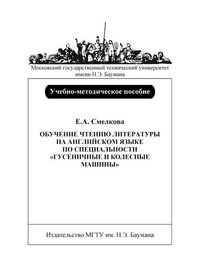Обучение чтению литературы на английском языке по специальности «Гусеничные и колесные машины»
Покупка
Тематика:
Английский язык
Автор:
Смелкова Елизавета Андреевна
Год издания: 2008
Кол-во страниц: 34
Дополнительно
Вид издания:
Учебно-методическая литература
Уровень образования:
ВО - Бакалавриат
Артикул: 840507.01.99
В учебно-методическое пособие включены тексты из оригинальной научно-технической английской и американской литературы по специальности «Гусеничные и колесные машины» для аудиторной и самостоятельной работы студентов. Каждый урок включает задания по развитию навыков перевода с английского языка на русский и с русского на английский, ведению беседы по основным проблемам, затронутым в пособии, а также лексические и
грамматические упражнения. Учебно-методическое пособие предназначено для студентов старших курсов, обучающихся по специальности «Гусеничные и колесные машины».
Тематика:
ББК:
УДК:
ОКСО:
- ВО - Бакалавриат
- 15.03.01: Машиностроение
- 15.03.02: Технологические машины и оборудование
- 15.03.03: Прикладная механика
ГРНТИ:
Скопировать запись
Фрагмент текстового слоя документа размещен для индексирующих роботов
Московский государственный технический университет имени Н.Э. Баумана Е.А. Смелкова ОБУЧЕНИЕ ЧТЕНИЮ ЛИТЕРАТУРЫ НА АНГЛИЙСКОМ ЯЗЫКЕ ПО СПЕЦИАЛЬНОСТИ «ГУСЕНИЧНЫЕ И КОЛЕСНЫЕ МАШИНЫ» Учебно-методическое пособие М о с к в а Издательство МГТУ им. Н.Э. Баумана 2 0 0 8
УДК 802.0
ББК 81.2 Англ-923
С501
Рецензент И.В. Стасенко
Смелкова Е.А.
Обучение чтению литературы на английском языке по
специальности «Гусеничные и колесные машины»: Учеб.метод. пособие. — М.: Изд-во МГТУ им. Н.Э. Баумана,
2008. — 34 с.
В
учебно-методическое
пособие
включены
тексты
из
оригинальной научно-технической английской и американской
литературы по специальности «Гусеничные и колесные машины»
для аудиторной и самостоятельной работы студентов. Каждый урок
включает задания по развитию навыков перевода с английского
языка на русский и с русского на английский, ведению беседы по
основным проблемам, затронутым в пособии, а также лексические и
грамматические упражнения.
Учебно-методическое пособие предназначено для студентов
старших курсов, обучающихся по специальности «Гусеничные и
колесные машины».
УДК 802.0
ББК 81.2 Англ-923
© МГТУ им. Н.Э. Баумана, 2008
С501
UNIT 1 1. New words and word combinations. take place быть, происходить combustion n сгорание occur v возникать, происходить arrange v располагать, организовывать converge v пересекать, пересекаться slide up and down v скользить вверх-вниз piston n поршень joint n шарнир, палец crank n колено (коленвала) bearing n подшипник clamp v закреплять, закрепляться, защелкиваться transmission n трансмиссия rotate v вращать, вращаться ignition n воспламенение, зажигание head n головка блока цилиндров throttle n дроссельная заслонка require v требовать lean a бедный, ненасыщенный valve n клапан manifold n коллектор pipe n трубопровод water-cooled a водоохлаждаемый 2. Pay attention to the translation of the following terms and learn them. To convert energy of gasoline combustion into motion — преобразовать энергию горения бензина в механическую энергию. Internal combustion engine (ICE) — двигатель внутреннего сгорания (ДВС).
Opposite cylinders — противоположно расположенные ци- линдры. Reciprocating (up-and-down) motions — возвратно-поступа- тельные движения. In-line engine — рядный двигатель. V-engine — v-образный двигатель (индукторный двигатель). W-engine — w-образный двигатель (трехрядный индукторный двигатель). Opposed, pancake, flat, or boxer engine — двигатель с проти- воположным расположением цилиндров (оппозитный двигатель). Connecting rod — шатун. Crankshaft — коленчатый вал. Drive wheel — ведущее колесо. Engine speed — частота вращений. Spark plug — свеча зажигания. Threaded aperture — резьбовое отверстие. Intake port — впускной патрубок. Exhaust pipe — выхлопная труба. Noise muffler — глушитель. Coil spring — винтовая пружина. Camshaft — кулачковый вал (распределительный вал). Carburetor — карбюратор. Fuel injector — топливный инжектор. Exhaust port — выпускной патрубок. Idling speed — холостой ход. Diesel engine — дизельный двигатель. Diesel fuel — дизельное топливо. Compression ratio — степень сжатия. Wide open throttle — широко открытая дроссельная заслонка. Partly open throttle — частично открытая дроссельная заслонка. Closed throttle — закрытая дроссельная заслонка. 3. Translate the following word combinations. The most common internal combustion engine. A single row with the centerlines of the cylinders vertical. A double row with the centerlines of opposite cylinders converging in a V. Two horizontal opposed rows. The mixture is rich at idling speed.


